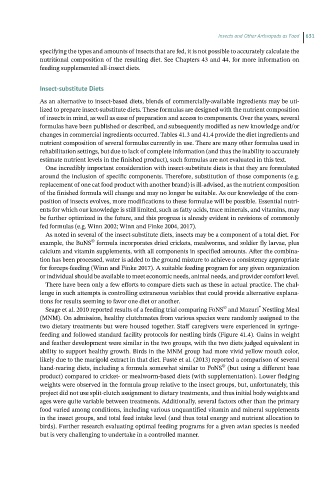Page 630 - Hand rearing birds second
P. 630
Insects and Other Arthropods as Food 631
specifying the types and amounts of insects that are fed, it is not possible to accurately calculate the
nutritional composition of the resulting diet. See Chapters 43 and 44, for more information on
feeding supplemented all-insect diets.
Insect-substituteDiets
As an alternative to insect-based diets, blends of commercially-available ingredients may be uti-
lized to prepare insect-substitute diets. These formulas are designed with the nutrient composition
of insects in mind, as well as ease of preparation and access to components. Over the years, several
formulas have been published or described, and subsequently modified as new knowledge and/or
changes in commercial ingredients occurred. Tables 41.3 and 41.4 provide the diet ingredients and
nutrient composition of several formulas currently in use. There are many other formulas used in
rehabilitation settings, but due to lack of complete information (and thus the inability to accurately
estimate nutrient levels in the finished product), such formulas are not evaluated in this text.
One incredibly important consideration with insect-substitute diets is that they are formulated
around the inclusion of specific components. Therefore, substitution of those components (e.g.
replacement of one cat food product with another brand) is ill-advised, as the nutrient composition
of the finished formula will change and may no longer be suitable. As our knowledge of the com-
position of insects evolves, more modifications to these formulae will be possible. Essential nutri-
ents for which our knowledge is still limited, such as fatty acids, trace minerals, and vitamins, may
be further optimized in the future, and this progress is already evident in revisions of commonly
fed formulas (e.g. Winn 2002; Winn and Finke 2004, 2017).
As noted in several of the insect-substitute diets, insects may be a component of a total diet. For
©
example, the BuNS formula incorporates dried crickets, mealworms, and soldier fly larvae, plus
calcium and vitamin supplements, with all components in specified amounts. After the combina-
tion has been processed, water is added to the ground mixture to achieve a consistency appropriate
for forceps-feeding (Winn and Finke 2017). A suitable feeding program for any given organization
or individual should be available to meet economic needs, animal needs, and provider comfort level.
There have been only a few efforts to compare diets such as these in actual practice. The chal-
lenge in such attempts is controlling extraneous variables that could provide alternative explana-
tions for results seeming to favor one diet or another.
©
®
Seage et al. 2010 reported results of a feeding trial comparing FoNS and Mazuri Nestling Meal
(MNM). On admission, healthy clutchmates from various species were randomly assigned to the
two dietary treatments but were housed together. Staff caregivers were experienced in syringe-
feeding and followed standard facility protocols for nestling birds (Figure 41.4). Gains in weight
and feather development were similar in the two groups, with the two diets judged equivalent in
ability to support healthy growth. Birds in the MNM group had more vivid yellow mouth color,
likely due to the marigold extract in that diet. Fusté et al. (2013) reported a comparison of several
©
hand-rearing diets, including a formula somewhat similar to FoNS (but using a different base
product) compared to cricket- or mealworm-based diets (with supplementation). Lower fledging
weights were observed in the formula group relative to the insect groups, but, unfortunately, this
project did not use split-clutch assignment to dietary treatments, and thus initial body weights and
ages were quite variable between treatments. Additionally, several factors other than the primary
food varied among conditions, including various unquantified vitamin and mineral supplements
in the insect groups, and total feed intake level (and thus total energy and nutrient allocation to
birds). Further research evaluating optimal feeding programs for a given avian species is needed
but is very challenging to undertake in a controlled manner.

